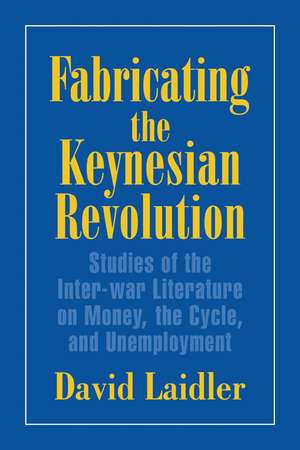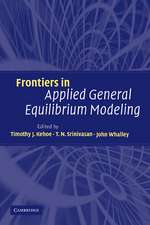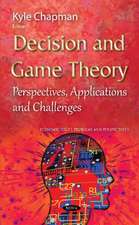Fabricating the Keynesian Revolution: Studies of the Inter-war Literature on Money, the Cycle, and Unemployment: Historical Perspectives on Modern Economics
Autor David Laidleren Limba Engleză Paperback – 27 mar 1999
| Toate formatele și edițiile | Preț | Express |
|---|---|---|
| Paperback (1) | 323.27 lei 6-8 săpt. | |
| Cambridge University Press – 27 mar 1999 | 323.27 lei 6-8 săpt. | |
| Hardback (1) | 873.43 lei 6-8 săpt. | |
| Cambridge University Press – 27 mar 1999 | 873.43 lei 6-8 săpt. |
Din seria Historical Perspectives on Modern Economics
-
 Preț: 322.86 lei
Preț: 322.86 lei -
 Preț: 200.09 lei
Preț: 200.09 lei -
 Preț: 277.57 lei
Preț: 277.57 lei -
 Preț: 307.58 lei
Preț: 307.58 lei -
 Preț: 288.62 lei
Preț: 288.62 lei -
 Preț: 277.65 lei
Preț: 277.65 lei -
 Preț: 430.14 lei
Preț: 430.14 lei -
 Preț: 350.91 lei
Preț: 350.91 lei - 11%
 Preț: 536.98 lei
Preț: 536.98 lei -
 Preț: 289.19 lei
Preț: 289.19 lei -
 Preț: 400.76 lei
Preț: 400.76 lei - 11%
 Preț: 577.27 lei
Preț: 577.27 lei -
 Preț: 331.09 lei
Preț: 331.09 lei -
 Preț: 357.37 lei
Preț: 357.37 lei -
 Preț: 395.17 lei
Preț: 395.17 lei -
 Preț: 286.69 lei
Preț: 286.69 lei - 14%
 Preț: 787.78 lei
Preț: 787.78 lei -
 Preț: 364.08 lei
Preț: 364.08 lei -
 Preț: 357.91 lei
Preț: 357.91 lei -
 Preț: 355.54 lei
Preț: 355.54 lei -
 Preț: 321.90 lei
Preț: 321.90 lei -
 Preț: 441.58 lei
Preț: 441.58 lei -
 Preț: 259.95 lei
Preț: 259.95 lei -
 Preț: 272.75 lei
Preț: 272.75 lei -
 Preț: 442.22 lei
Preț: 442.22 lei -
 Preț: 414.74 lei
Preț: 414.74 lei - 14%
 Preț: 728.05 lei
Preț: 728.05 lei -
 Preț: 266.98 lei
Preț: 266.98 lei -
 Preț: 392.82 lei
Preț: 392.82 lei -
 Preț: 309.49 lei
Preț: 309.49 lei
Preț: 323.27 lei
Nou
Puncte Express: 485
Preț estimativ în valută:
61.88€ • 67.24$ • 52.01£
61.88€ • 67.24$ • 52.01£
Carte tipărită la comandă
Livrare economică 21 aprilie-05 mai
Preluare comenzi: 021 569.72.76
Specificații
ISBN-13: 9780521645966
ISBN-10: 0521645964
Pagini: 400
Ilustrații: 1 b/w illus.
Dimensiuni: 153 x 229 x 23 mm
Greutate: 0.55 kg
Ediția:New.
Editura: Cambridge University Press
Colecția Cambridge University Press
Seria Historical Perspectives on Modern Economics
Locul publicării:New York, United States
ISBN-10: 0521645964
Pagini: 400
Ilustrații: 1 b/w illus.
Dimensiuni: 153 x 229 x 23 mm
Greutate: 0.55 kg
Ediția:New.
Editura: Cambridge University Press
Colecția Cambridge University Press
Seria Historical Perspectives on Modern Economics
Locul publicării:New York, United States
Cuprins
Introduction; 1. An overview; Part I. The Wicksellians: 2. Wicksellian origins; 3. The macrodynamics of the Stockholm school; Part II. The Marshallian Tradition in Britain: 4. Cambridge cycle theory: Lavington, Pigou and Robertson; 5. The monetary element in the Cambridge tradition; 6. The Treatise on Money and related contributions; 7. British discussions of unemployment; Part III. American Analysis of Money and the Cycle: 8. American macroeconomics between World War I and the Depression; 9. American macroeconomics in the early 1930s; Part IV. Keynes, the Classical and IS-LM: 10. The General Theory; 11. The classics and Mr. Keynes; 12. IS-LM and the General Theory; 13. Selective synthesis; References.
Recenzii
"Natura non facit saltum. So said Marshall, and once again he's been proven correct. Without denigrating the very real contributions of John Maynard Keynes, David Laidler demonstrates conclusively that, far from inventing an entirely novel theory to challenge a dead orthodoxy, Keynes fabricated his theory from the ample materials provided by a lively and diverse interwar literature. Fabricating the Keynesian Revolution sets Keynes's work in the theoretical context of its period as no other book has. It is must reading not only for historians of economics but for anyone who wants to understand how modern macroeconomics came to be." Neil Skaggs, Illinois State University
"For persons entering economics in the 1940s, 'Keynesian' economics was shockingly 'revolutionary' because it was shockingly activist by comparison with all earlier, other than Marxian, economic teaching. Laidler's book brilliantly traces the 'fabrification' of a textbook revolution in activist economics which in one generation replaced thoughtful Marshallian courses in economic inquiry with courses in soapbox oratory about economic fluctuations. Laidler's scholarship is impeccable; even the most knowledgable professional has much to learn from reading his book." Robert Clower, University of South Carolina
"David Laidler has written an important, scholarly, and controversial study of the diverse strands of monetary economics between the wars, showing how Austrian, Swedish, American institutionalist, and Marshallian traditions of cycle analysis, and Keynes's own earlier work, contributed along with Keynes's General Theory to the emergence of modern macroeconomics. Laidler's wide-ranging, learned, and provocative analysis deepens our understanding of the richness of interwar macroeconomics, and will stimulate a lively debate on the role of Keynes in the development of macroeconomics." Robert Dimand, Brock University, Canada
"...brilliantly conceived and splendidly executed...No one interested in the economics or the economic history of the interwar period should fail to read it." Journal of Economics, Susan Showson, University of Toronto
"For persons entering economics in the 1940s, 'Keynesian' economics was shockingly 'revolutionary' because it was shockingly activist by comparison with all earlier, other than Marxian, economic teaching. Laidler's book brilliantly traces the 'fabrification' of a textbook revolution in activist economics which in one generation replaced thoughtful Marshallian courses in economic inquiry with courses in soapbox oratory about economic fluctuations. Laidler's scholarship is impeccable; even the most knowledgable professional has much to learn from reading his book." Robert Clower, University of South Carolina
"David Laidler has written an important, scholarly, and controversial study of the diverse strands of monetary economics between the wars, showing how Austrian, Swedish, American institutionalist, and Marshallian traditions of cycle analysis, and Keynes's own earlier work, contributed along with Keynes's General Theory to the emergence of modern macroeconomics. Laidler's wide-ranging, learned, and provocative analysis deepens our understanding of the richness of interwar macroeconomics, and will stimulate a lively debate on the role of Keynes in the development of macroeconomics." Robert Dimand, Brock University, Canada
"...brilliantly conceived and splendidly executed...No one interested in the economics or the economic history of the interwar period should fail to read it." Journal of Economics, Susan Showson, University of Toronto
Descriere
Examining the emergence, in the inter-war years, of what came to be called 'Keynesian macroeconomics'.












